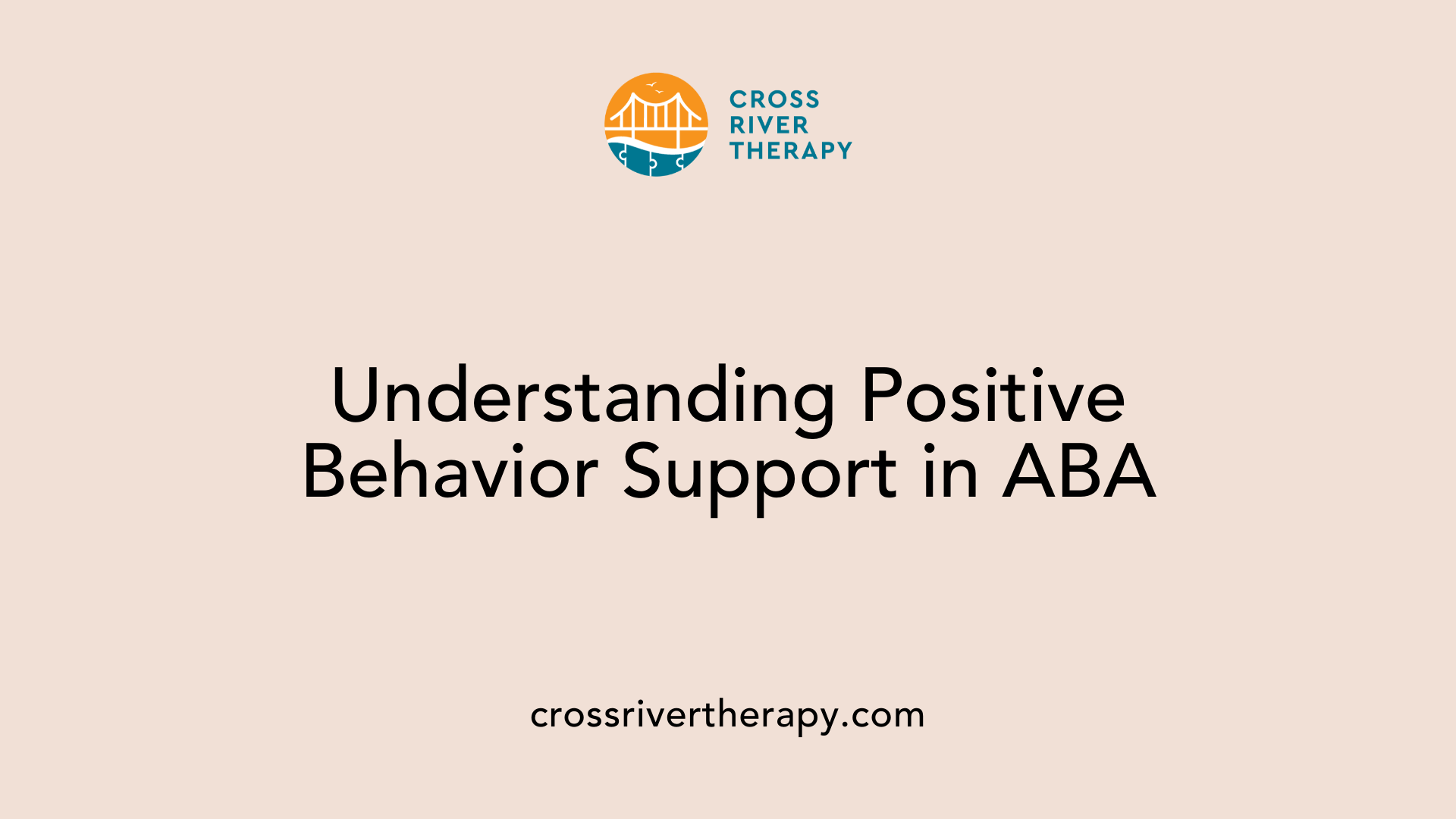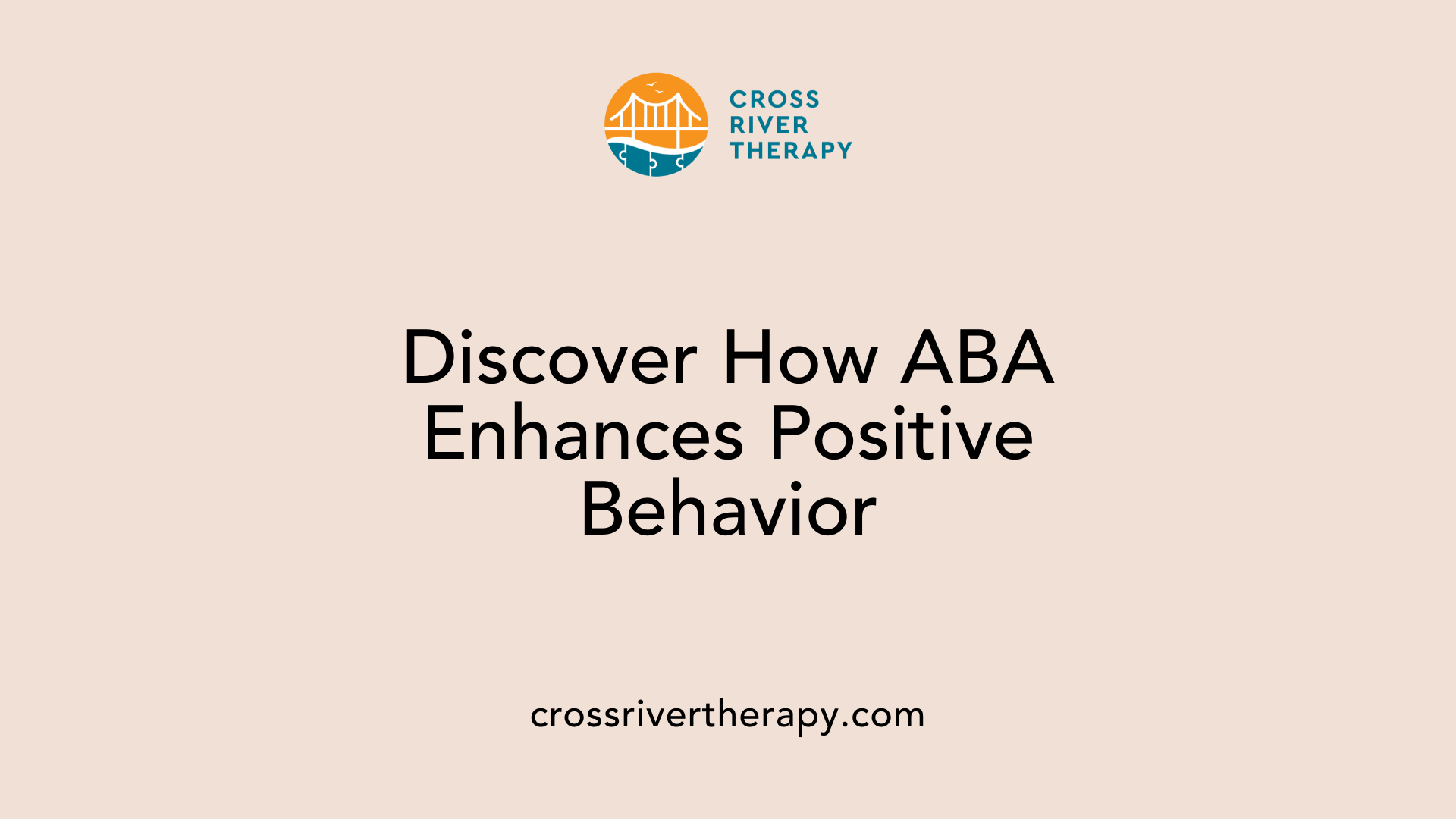How ABA Promotes Positive Behaviors
Exploring the Impact of ABA on Positive Behavioral Changes
Introduction to ABA and Its Influence
Applied Behavior Analysis (ABA) is a well-established therapy that has gained recognition for its effectiveness in modifying behaviors, particularly in individuals with autism spectrum disorder (ASD). This approach combines principles of learning and behavior science to increase positive behaviors, enrich social interactions, and enhance overall quality of life. ABA therapy employs a range of strategies, with positive reinforcement being a cornerstone technique, to achieve these goals. As we delve into how ABA promotes positive behaviors, we uncover the diverse methodologies and the profound impact they have on individuals, families, and communities.
Understanding Applied Behavior Analysis (ABA)

What is Applied Behavior Analysis (ABA)?
Applied Behavior Analysis (ABA) is a therapeutic approach that centers on understanding and improving behavior through the science of learning. Its main goals include increasing desirable behaviors and decreasing harmful ones, particularly in children with autism. ABA techniques, such as positive reinforcement, are employed to encourage positive behaviors while minimizing negative ones. Each program is tailored to meet the individual's needs, often requiring a commitment of 25 to 40 hours of therapy per week over a span of 1 to 3 years.
Empirical evidence and professional endorsements
Numerous studies have demonstrated the efficacy of ABA in improving critical life skills like communication, social interaction, and self-care. The therapy is recognized as an evidence-based practice by leading organizations, including the US Surgeon General and the American Psychological Association, underscoring its credibility in assisting children with autism and related developmental disorders. However, while ABA is endorsed for its positive impacts, it has also faced scrutiny over its past practices and public perception.
Methodologies within ABA
ABA encompasses several methodologies to address behavioral changes effectively. Notable techniques include:
| Methodology | Description | Example Use Case |
|---|---|---|
| Discrete Trial Training (DTT) | Breaks down learning into manageable steps, focusing on specific behaviors. | Teaching children to follow instructions by using step-by-step reinforcement. |
| Pivotal Response Training (PRT) | A play-based technique that promotes broader skills such as motivation and self-management. | Encouraging social interactions and interest through games. |
| Picture Exchange Communication System (PECS) | Uses pictures to facilitate communication in individuals with limited verbal skills. | Allowing non-verbal children to express their needs via picture cards. |
Through these methodologies, ABA fosters an environment conducive to learning and behavior modification, paving the way for individuals to achieve greater independence and a higher quality of life.
Core Techniques of ABA Therapy

What are common techniques used in ABA therapy?
Common techniques used in ABA therapy include:
- Positive Reinforcement: A fundamental strategy that rewards desired behaviors to increase their frequency. Examples include verbal praises like "Great job!" or tangible rewards like tokens.
- Discrete Trial Training (DTT): This method breaks learning into manageable segments, focusing on teachable moments. Each trial includes a specific instruction, a child’s response, and feedback, reinforcing correct answers effectively.
- Modeling: Therapists demonstrate the desired behavior, allowing children to imitate actions and learn new skills through observation.
- Picture Exchange Communication System (PECS): This innovative approach assists non-verbal individuals by using images, enabling them to express needs and emotions clearly.
Additional Techniques in ABA
- Antecedent-based Interventions: These strategies modify the environment to minimize distractions, aiming to reduce and prevent undesired behaviors.
- Functional Communication Training (FCT) and Pivotal Response Training (PRT): FCT focuses on enhancing communication skills, while PRT promotes self-management and motivation through play-based learning.
- Redirection and Prompting: These techniques guide children towards appropriate behaviors and help foster independence, supporting overall behavioral goals.
By combining these techniques, ABA therapy addresses challenging behaviors and promotes positive skills, fostering a supportive learning environment.
Harnessing Positive Reinforcement in ABA

How does Applied Behavior Analysis utilize positive reinforcement?
Applied Behavior Analysis (ABA) utilizes positive reinforcement to encourage desired behaviors in individuals, particularly those with autism spectrum disorder (ASD). By introducing a rewarding stimulus following a desired behavior, such as verbal praise or tangible rewards, ABA increases the likelihood that these behaviors will be repeated in the future.
Mechanism and examples of positive reinforcement
Different types of positive reinforcement are employed in ABA, including:
- Tangible items: Rewards such as toys or treats.
- Social praise: Verbal acknowledgment like "Great job!"
- Preferred activities: Extra time for cherished hobbies.
These reinforcers are tailored to match individual preferences and needs, greatly enhancing the effectiveness of the approach. Techniques like Token Economy, Discrete Trial Training, and Natural Environment Training incorporate positive reinforcement, making the learning process more engaging and motivating.
Tailoring reinforcers to individual needs
Identifying effective reinforcers is crucial, as each individual's motivations can vary significantly. This customization helps in establishing a strong connection between the behavior and its appreciation. Moreover, frequent adjustments based on ongoing assessments ensure that the reinforcers remain relevant and continue to evoke positive responses.
Role in skill development
Overall, positive reinforcement plays a vital role in building skills, boosting self-esteem, and improving social interactions. It promotes a supportive environment that encourages individuals to engage with challenges actively. As a result, positive reinforcement contributes to a higher quality of life for those undergoing ABA therapy.
Practical Examples of Positive Reinforcement
How Does ABA Use Positive Reinforcement?
Applied Behavior Analysis (ABA) employs positive reinforcement in several impactful ways to encourage desirable behaviors. For instance, when a student like Sally responds correctly to a question, receiving praise from her teacher not only boosts her confidence but also increases the likelihood she will participate more actively in the future. This method highlights the critical connection between actions and their positive outcomes.
What Forms Can Reinforcers Take?
Reinforcers in ABA can vary widely and include:
- Verbal Praise: Words of affirmation, such as saying "Great job!" or "You did it!"
- Tangible Rewards: Items like stickers, toys, or certificates, which provide a concrete reward for desired behaviors.
- Activity-Based Rewards: Opportunities to engage in preferred activities, such as extra playtime or a movie break, tailored to individual interests.
Techniques such as token economies are also prevalent. In this system, individuals earn tokens for displaying positive behaviors, which they can later exchange for larger rewards, adding a visual tracking element that further motivates engagement.
Immediate Reinforcement and Its Impact
The effectiveness of positive reinforcement lies in its immediacy and specificity. Providing a reward right after a behavior reinforces the connection between the action and the outcome. For example, if a child is praised within moments of using polite language, the association strengthens this behavior, making it more likely to occur in the future.
Outcomes of Using Positive Reinforcement
Using positive reinforcement leads to a supportive and motivating environment, enhancing children's self-esteem and encouraging engagement in learning. As they receive feedback on what they do well, they are more inclined to repeat those actions, promoting overall growth and improved interpersonal relationships.
The Role of Positive Behavior Support (PBS)

What is Positive Behavior Support (PBS) in ABA?
Positive Behavior Support (PBS) is a comprehensive set of research-based strategies designed to enhance the quality of life and decrease problem behaviors. It focuses on skill development and environmental modifications, aiming to prioritize valued outcomes. PBS does not merely address negative behaviors but actively fosters individual success, personal satisfaction, and positive social interactions.
Integration with ABA
PBS integrates principles from behavioral and biomedical sciences to examine the dynamic relationship between behavior and environmental factors. By using Modular approaches from Applied Behavior Analysis (ABA), PBS thoroughly assesses how context influences behavior. This integration is instrumental in tailoring strategies that resonate with individual needs, thereby increasing the effectiveness of interventions.
Strategies to enhance quality of life
Core practices within PBS include the Functional Behavioral Assessment (FBA), which investigates the reasons behind challenging behaviors. Tailoring interventions based on FBA findings helps individuals overcome difficulties by developing alternative, appropriate behaviors. Proactive strategies such as teaching communication skills or creating supportive environments significantly contribute to enhanced quality of life and encourage positive social occurrences.
Cultural and practical adaptations
Culturally sensitive adaptations are essential for the effectiveness of PBS. Understanding diverse cultural backgrounds helps in developing intervention plans that respect individual values and community practices. Practical adaptations might involve customizing interventions to address the specific challenges faced by different families, thereby promoting inclusivity and sustainability in behavior support strategies.
Through these structured approaches, PBS empowers individuals to thrive in their environments, ultimately leading to more fulfilling lives.
Effectiveness of ABA in Promoting Positive Behaviors

How does ABA therapy promote positive behaviors?
ABA therapy promotes positive behaviors by focusing on individualized learning plans that target specific skills and behaviors essential for improving the quality of life of individuals with autism. It employs evidence-based strategies, particularly positive reinforcement, to encourage desirable behaviors while reducing harmful ones. By using the ABC (antecedent, behavior, consequence) model, behavior analysts systematically reinforce positive actions with immediate rewards, enhancing their occurrence.
The therapy adapts to the unique needs of each person, ensuring that progress is monitored regularly and programs evolve as skills develop. This responsiveness is key to increasing the effectiveness of interventions. Additionally, family involvement is emphasized; parents and caregivers are trained to reinforce learned behaviors in everyday situations, fostering a supportive environment that enriches the individual's experience.
Evidence and research on ABA outcomes
Research supports the effectiveness of ABA therapy, demonstrating significant improvements in various skills for individuals with autism. Over 20 studies highlight the success of ABA in enhancing intellectual functioning, language development, and crucial daily living skills. Long-term applications of ABA therapy have proven to reduce problematic behavior and foster better social interactions, crucial for navigating real-world scenarios.
Skill development and life improvement
Individuals who undergo ABA therapy benefit from improved communication, social skills, and self-management abilities. These improvements promote their independence, enabling them to interact more positively with peers and family members. Furthermore, customized ABA programs help in teaching essential life skills, including self-care routines, which substantially enhance overall quality of life.
Customization of ABA programs
A defining feature of ABA therapy is its customization. Each program is developed based on individual assessments that identify specific strengths and challenges. Techniques, such as Discrete Trial Training and Pivotal Response Training, are tailored to engage individuals effectively, ensuring that the learning process resonates with their interests. This tailored approach not only maximizes engagement but also allows for generalization of skills across different environments, reinforcing learning in school and at home.
Addressing Concerns About ABA Therapy
Are there any concerns about the potential harm of ABA therapy?
Concerns surrounding ABA therapy, particularly its ethical implications, have emerged from various advocacy groups and researchers. Critics have pointed out the historical reliance on punishment methods in ABA, which can traumatize autistic individuals rather than empower them. The emphasis on behavioral conformity may inadvertently minimize the importance of addressing the emotional and psychological well-being of children with autism. Furthermore, there are concerns that ABA's focus on eliminating certain behaviors, rather than understanding the underlying reasons for them, can lead to a disregard for individuality.
Although contemporary ABA practices have evolved and moved away from aversive techniques, residual skepticism remains. Advocates for neurodiversity argue for the need to respect different ways of being, advocating for a balance between fostering independence and honoring authentic self-expression. These discussions highlight a critical dialogue about how to best support individuals with autism in ways that are both ethical and rooted in respect for their unique needs.
Modern changes in ABA practices
In response to earlier criticisms, ABA therapy has progressively transformed, embracing more compassionate, child-centered approaches. Modern methodologies prioritize understanding the individual’s perspectives and preferences, incorporating play-based activities that enhance engagement. By leveraging techniques that promote positive behaviors without punitive measures, today's ABA practices aim to maintain a nurturing environment.
Moreover, the integration of Positive Behavior Support (PBS) with ABA techniques emphasizes proactive strategies that respect the dignity of individuals with autism. This evolution reflects a broader trend towards inclusivity, ensuring that therapy is not just about behavior modification but also about fostering a positive quality of life.
Diverse Interventions in ABA Therapy
What are examples of ABA interventions?
ABA therapy implements a variety of effective interventions tailored to meet each individual's needs. One prominent example is Positive Reinforcement, where rewards or praise are given to individuals to encourage and repeat desired behaviors. This creates an encouraging environment conducive to learning.
Another significant approach is Discrete Trial Training (DTT), which breaks down skills into smaller, manageable parts. This method capitalizes on teachable moments to reinforce targeted behaviors while addressing any negative patterns.
Antecedent-based Interventions modify the environment to prevent undesired behaviors by increasing the likelihood of appropriate actions. For instance, altering classroom layouts or schedules can lead to fewer distractions.
Functional Communication Training (FCT) is particularly essential; it teaches individuals to replace problem behaviors with suitable communication strategies—like using words instead of acting out.
Additionally, techniques like modeling, where instructors demonstrate ideal behaviors, and scripting, which provides pre-written phrases, are employed to facilitate smoother social interactions.
These interventions are employed across various settings, providing crucial support for individuals with autism and other developmental challenges, ultimately promoting positive behavioral changes.
Conclusion: The Future of ABA Therapy
As ABA therapy continues to evolve, its focus remains on fostering positive behavior changes and improving the quality of life for individuals, particularly those with developmental disorders like autism. The techniques within ABA, especially positive reinforcement, have demonstrated significant efficacy in encouraging desired behaviors and enhancing social skills. Despite the criticisms it faces, ongoing improvements and modernization of practices show promise in addressing ethical concerns while respecting the unique needs of each individual. With continued research and adaptation, ABA therapy has the potential to further solidify its role in empowering individuals to reach their potential and lead fulfilling lives.
References
- How ABA Interventions Promote Positive Behavior
- How Does ABA Therapy Utilize Positive Reinforcement?
- Applied Behavior Analysis (ABA) | Autism Speaks
- The Power of Positive Reinforcement in ABA
- Applied Behavior Analysis: Encouraging Positive Behaviors
- ABA Therapy And Positive Behavior Supports Unveiled
- 5 Ways To Use Positive Reinforcement In ABA Therapy
- Peer Play: Facilitating Positive Social Interactions for Autism
- The Role of Positive Reinforcement in ABA Therapy



